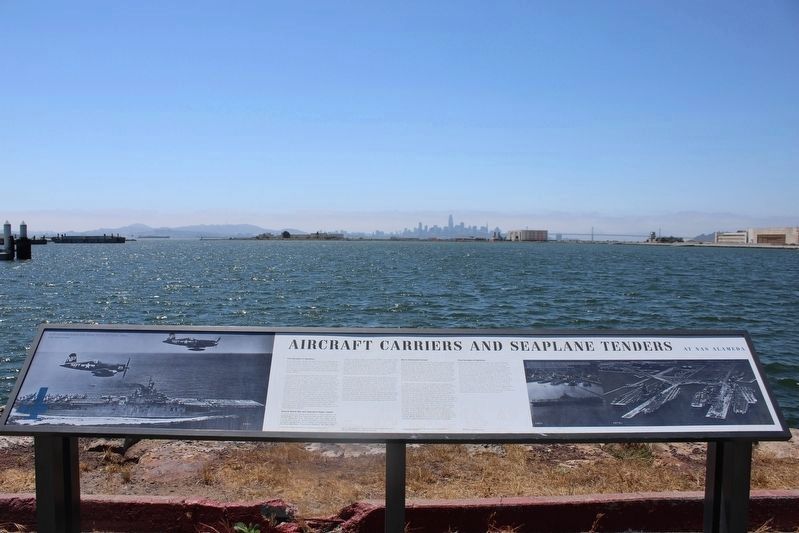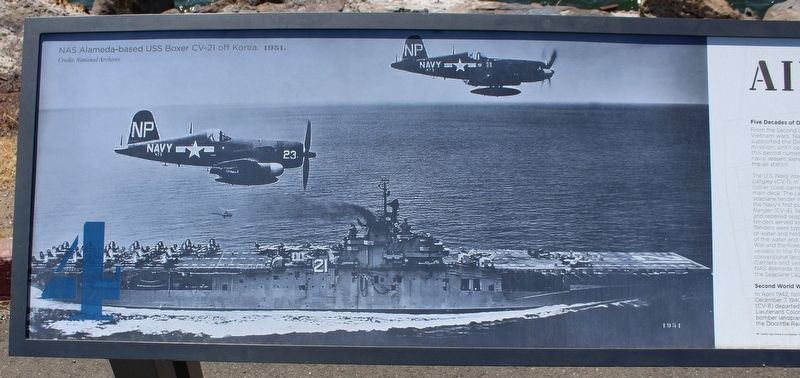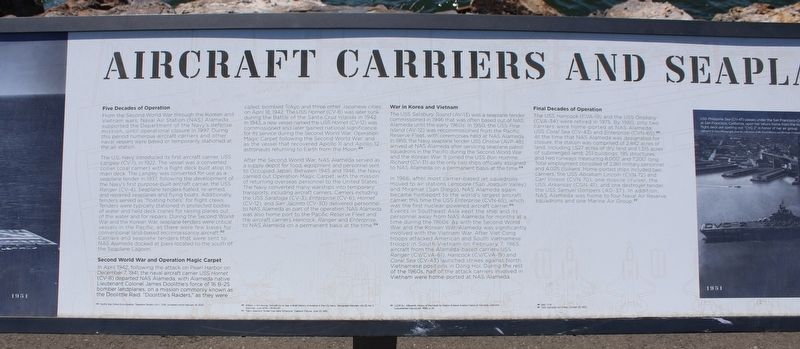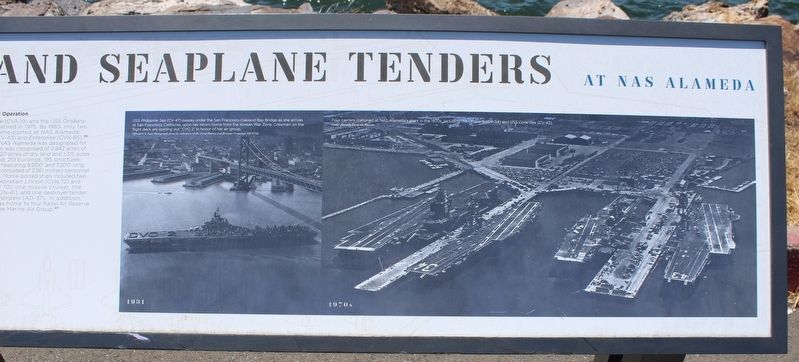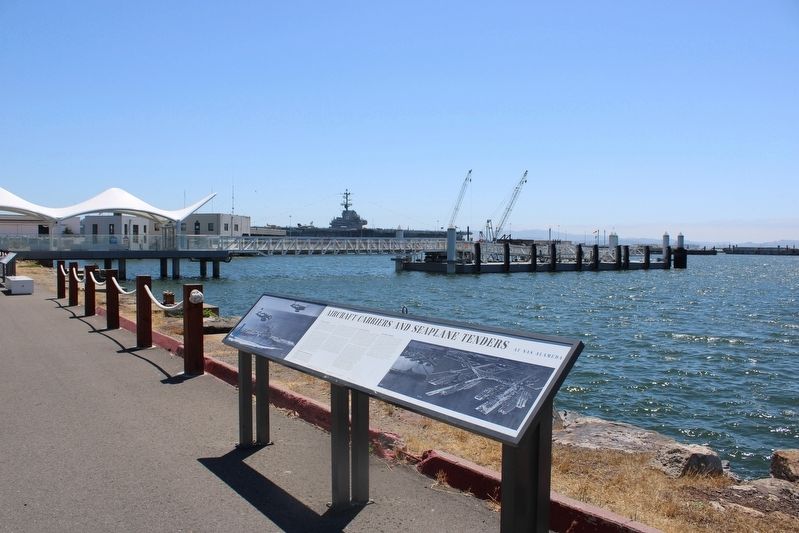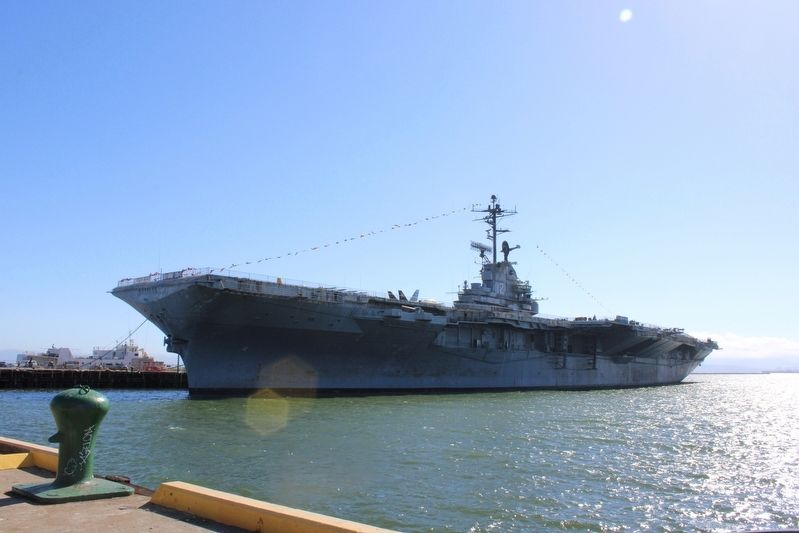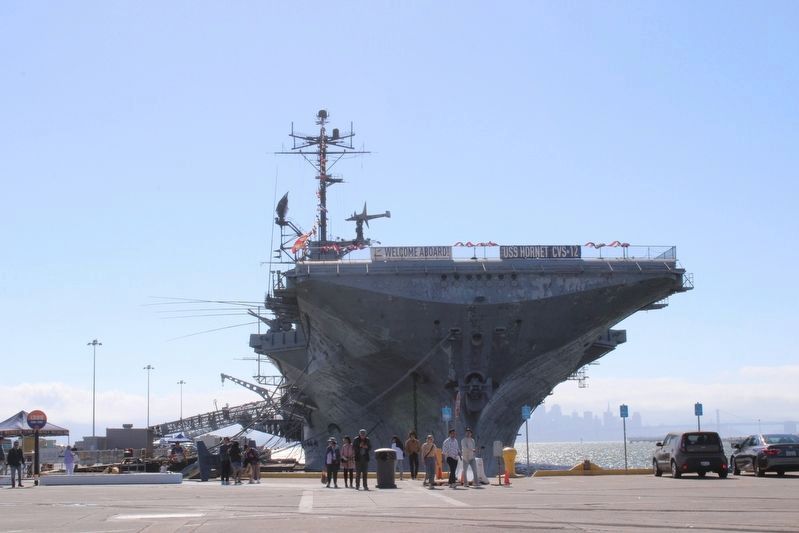Alameda in Alameda County, California — The American West (Pacific Coastal)
Aircraft Carriers and Seaplane Tenders
At NAS Alameda
Inscription.
Five Decades of Operation
From the Second World War through the Korean and Vietnam wars, Naval Air Station (NAS) Alameda supported the Department of the Navy's defense mission, until operational closure in 1997. During this period numerous aircraft carriers and other naval vessels were based or temporarily stationed at the air station.
The U.S. Navy introduced its first aircraft carrier, USS Langley (CV-1), in 1922. The vessel was a converted collier (coal carrier) with a flight deck built atop its main deck. The Langley was converted for use as a seaplane tender in 1937, following the development of the Navy's first purpose-built aircraft carrier, the USS Ranger (CV-4). Seaplane tenders fueled, re-armed, and repaired seaplanes and flying boats. Additionally, tenders served as "floating hotels" for flight crews. Tenders were typically stationed in protected bodies of water and held deck cranes for raising planes out of the water and for repairs. During the Second World War and the Korean War, seaplane tenders were critical vessels in the Pacific, as there were few bases for conventional land-based reconnaissance aircraft.22 Carriers and seaplane tenders that were sent to NAS Alameda docked at piers located to the south of the Seaplane Lagoon.
Second World War and Operation Magic Carpet
In April 1942, following the attack on Pearl Harbor on December 7, 1941, the naval aircraft carrier USS Hornet (CV-8) departed NAS Alameda, with Alameda native Lieutenant Colonel James Doolittle's force of 16 B-25 bomber landplanes, on a mission commonly known as the Doolittle Raid. "Doolittle's Raiders," as they were called, bombed Tokyo and three other Japanese cities on April 18, 1942. The USS Hornet (CV-8) was later sunk during the Battle of the Santa Cruz Islands in 1942. In 1943, a new vessel named the USS Hornet (CV-12) was commissioned and later gained national significance for its service during the Second World War; Operation Magic Carpet following the Second World War; and as the vessel that recovered Apollo 11 and Apollo 12 astronauts returning to Earth from the Moon.23
After the Second World War, NAS Alameda served as a supply depot for food, equipment and personnel sent to Occupied Japan. Between 1945 and 1946, the Navy carried out Operation Magic Carpet, with the mission of returning overseas personnel to the United States. The Navy converted many warships into temporary transports, including aircraft carriers. Carriers including the USS Saratoga (CV-3), Enterprise (CV-6), Hornet (CV-12), and San Jacinto (CV-30) delivered personnel to NAS Alameda as
part of the operation. NAS Alameda was also home port to the Pacific Reserve Fleet and the aircraft carriers Hancock, Ranger and Enterprise, to NAS Alameda on a permanent basis at the time.24
War in Korea and Vietnam
The USS Salisbury Sound (AV-13) was a seaplane tender commissioned in 1946 that was often based out of NAS Alameda until the early 1960s. In 1950, the USS Pine Island (AV-12) was recommissioned from the Pacific Reserve Fleet, with ceremonies held at NAS Alameda. In 1955, the Navy seaplane tender USS Onslow (AVP-48) arrived at NAS Alameda after servicing seaplane patrol squadrons in the Pacific during the Second World War and the Korean War. It joined the USS Bon Homme Richard (CV-31) as the only two ships officially assigned to NAS Alameda on a permanent basis at the time.24
In 1966, after most carrier-based jet squadrons moved to air stations Lemoore (San Joaquin Valley) and Miramar (San Diego), NAS Alameda again became homeport to the world's largest aircraft carrier, this time the USS Enterprise (CVN-65), which was the first nuclear-powered aircraft carrier.25 Events in Southeast Asia kept the ship and its personnel away from NAS Alameda for months at a time during the 1960s. As with the Second World War and the Korean
War, Alameda was significantly involved with the Vietnam War. After Viet Cong troops attacked American and South Vietnamese troops in South Vietnam on February 7, 1965, aircraft from the Alameda-based carriers USS Ranger (CV/CVA-61), Hancock (CV/CVA-19) and Coral Sea (CV-43) launched strikes against North Vietnamese positions in Dong Hoi. During the rest of the 1960s, half of the attack carriers involved in Vietnam were home-ported at NAS Alameda.
Final Decades of Operation
The USS Hancock (CVA-19) and the USS Oriskany (CVA-34) were retired in 1975. By 1980, only two carriers were home-ported at NAS Alameda: USS Coral Sea (CV-43) and Enterprise (CVN-65).26 At the time that NAS Alameda was designated for closure, the station was comprised of 2,842 acres of land, including 1,527 acres of dry land and 1,315 acres of submerged land; 251 buildings; 195 structures; and two runways measuring 8,000' and 7,200' long. Total employment consisted of 2,861 military personnel and 4,025 civilians. Home-ported ships included two carriers, the USS Abraham Lincoln (CVN 72) and Carl Vinson (CVN 70); one missile cruiser, the USS Arkansas (CGN-41); and one destroyer tender, the USS Samuel Gompers (AD-37). In addition, NAS Alameda was home to four Naval Air Reserve squadrons and one
Marine Air Group.27 (Marker Number 4.)
Topics. This historical marker is listed in these topic lists: Air & Space • Waterways & Vessels. A significant historical year for this entry is 1922.
Location. 37° 46.663′ N, 122° 17.902′ W. Marker is in Alameda, California, in Alameda County. Marker is on Ferry Point north of Oriskany Avenue, on the right when traveling south. The resin marker is mounted to metal posts to the right of the entrance to the Alameda Seaplane Lagoon Ferry Terminal. Touch for map. Marker is in this post office area: Alameda CA 94501, United States of America. Touch for directions.
Other nearby markers. At least 8 other markers are within walking distance of this marker. Seaplanes and Flying Boats at NAS Alameda (within shouting distance of this marker); Seaplane Lagoon (within shouting distance of this marker); Alameda: Bay Area Aviation Center (about 300 feet away, measured in a direct line); Douglas SBD Dauntless (approx. 0.2 miles away); Grumman J2F Duck (approx. 0.2 miles away); Vought A-7A Corvair II (approx. 0.2 miles away); Grumman F6F Hellcat (approx. 0.2 miles away); The Jimmy Doolittle Pier – Alameda Naval Air Station (approx. 0.4 miles away). Touch for a list and map of all markers in Alameda.
More about this marker.
22 Pacific War Online Encyclopedia, “Seaplane Tenders (AV), “ 2016. Accessed online February 19, 2020.
23
William J. Armstrong, “Aircraft Go to Sea: A Brief History of Aviation in the U.S. Navy,” Aerospace Historian, Vol 25, No. 2 (Summer, June 1978), (79-91), 87.
24 ”Navy Seaplane Tender Due Here Tomorrow,” Oakland Tribune, June 23, 1955.
25 LCDR B.L. Allbrandt, History of the Naval Air Station & Naval Aviation Depot at Alameda, California (unpublished manuscript: 1996), p. 14.
26 Ibid, 17-19
27 NAS Alameda Fact Sheet, October 20, 1993.
Inset Images:
NAS Alameda-based USS Boxer CV-21 off Korea. 1951. Credit: National Archives
USS Philippine Sea (CV-47) passes under the San Francisco-Oakland Bay Bridge as she arrives at San Francisco, California, upon her return home from the Korean War Zone. Crewmen on the flight deck are spelling out “CVG2” in honor of her air group. Official U.S. Navy photograph from the collection of the Naval History and Heritage Command, NH 97322
Four carriers stationed at NAS Alameda’s piers in the 1970s, including the Oriskany (CV-34) and USS Coral Sea (CV-43). Credit: Alameda Naval Air museum
Also see . . .
1. Former Naval Air Station Alameda. Naval Facilities Engineering Systems Command Base
"NAS Alameda was commissioned in 1940 and played a critical role in the Navy’s defense mission following Japan’s attack on Pearl Harbor, December 7, 1941. NAS Alameda’s primary wartime mission was simplified -- “keep ‘em flying” from airfields and carriers. The base piped massive quantities of men, machinery, and supplies across the Pacific. Station records document 230,000 man hours logged in December 1941; at peak production in July 1945, this figure would exceed 2,000,000 man-hours in around the clock operations."(Submitted on September 11, 2023, by Joseph Alvarado of Livermore, California.)
2. History of NAS Alameda. Alameda Naval Air Museum
"The history of NAS Alameda is a remarkable story. It was one of the largest, most complete Naval Air Stations in the world. It was commissioned on November 1, 1940 and commanded by Captain Frank McCrary. "(Submitted on September 11, 2023, by Joseph Alvarado of Livermore, California.)
Credits. This page was last revised on September 12, 2023. It was originally submitted on September 11, 2023, by Joseph Alvarado of Livermore, California. This page has been viewed 99 times since then and 39 times this year. Photos: 1, 2, 3, 4, 5, 6, 7. submitted on September 11, 2023, by Joseph Alvarado of Livermore, California.
